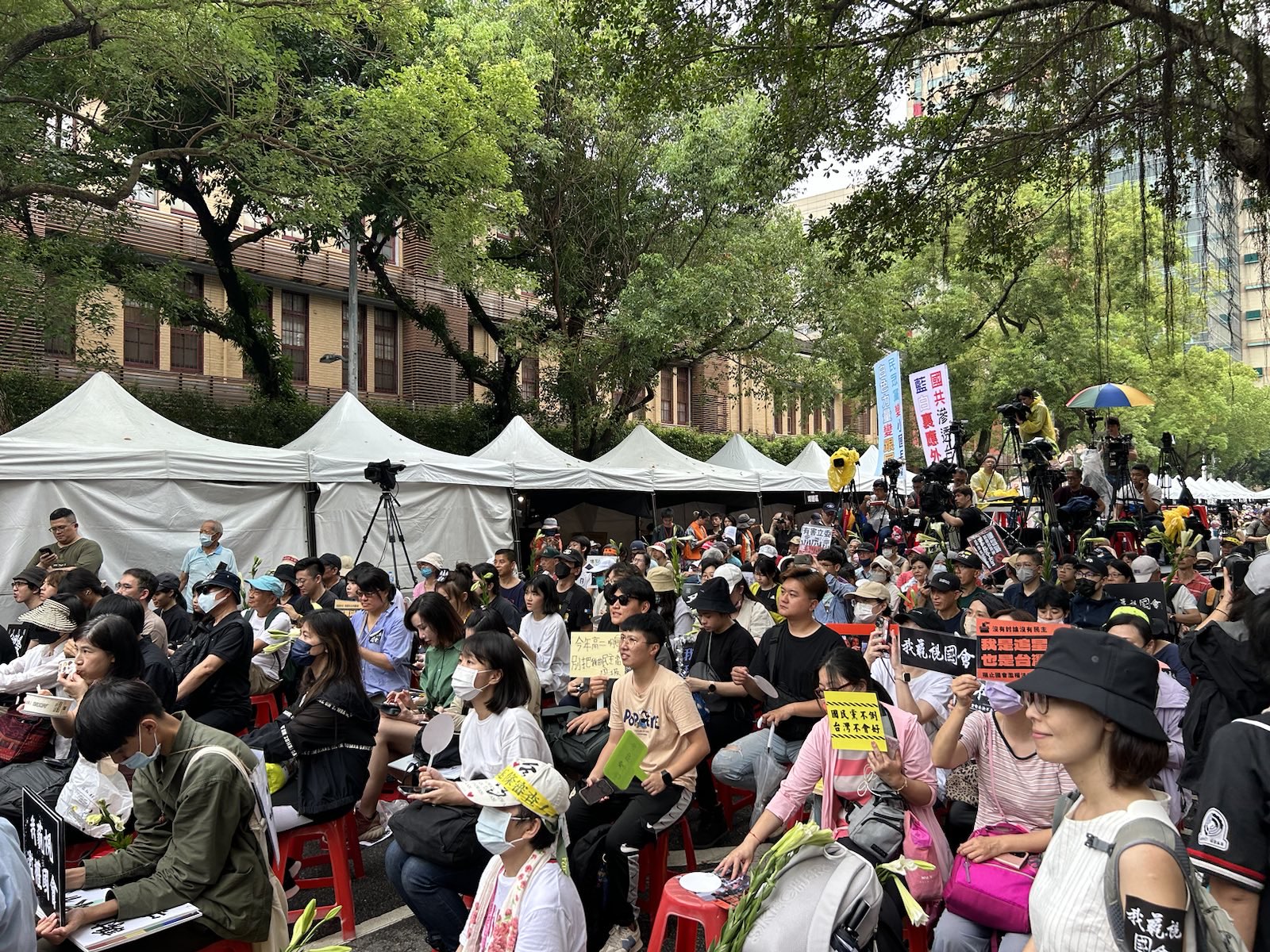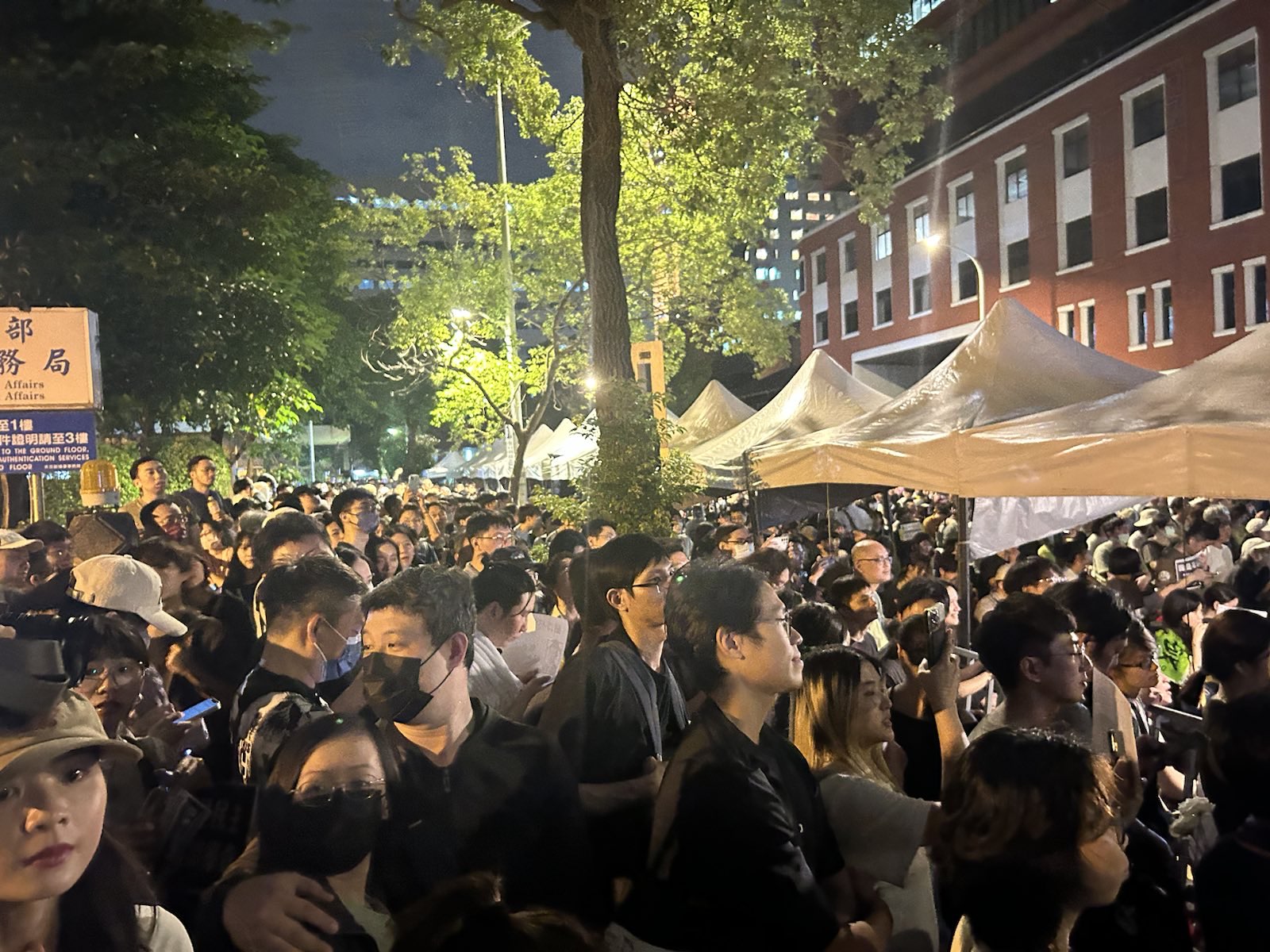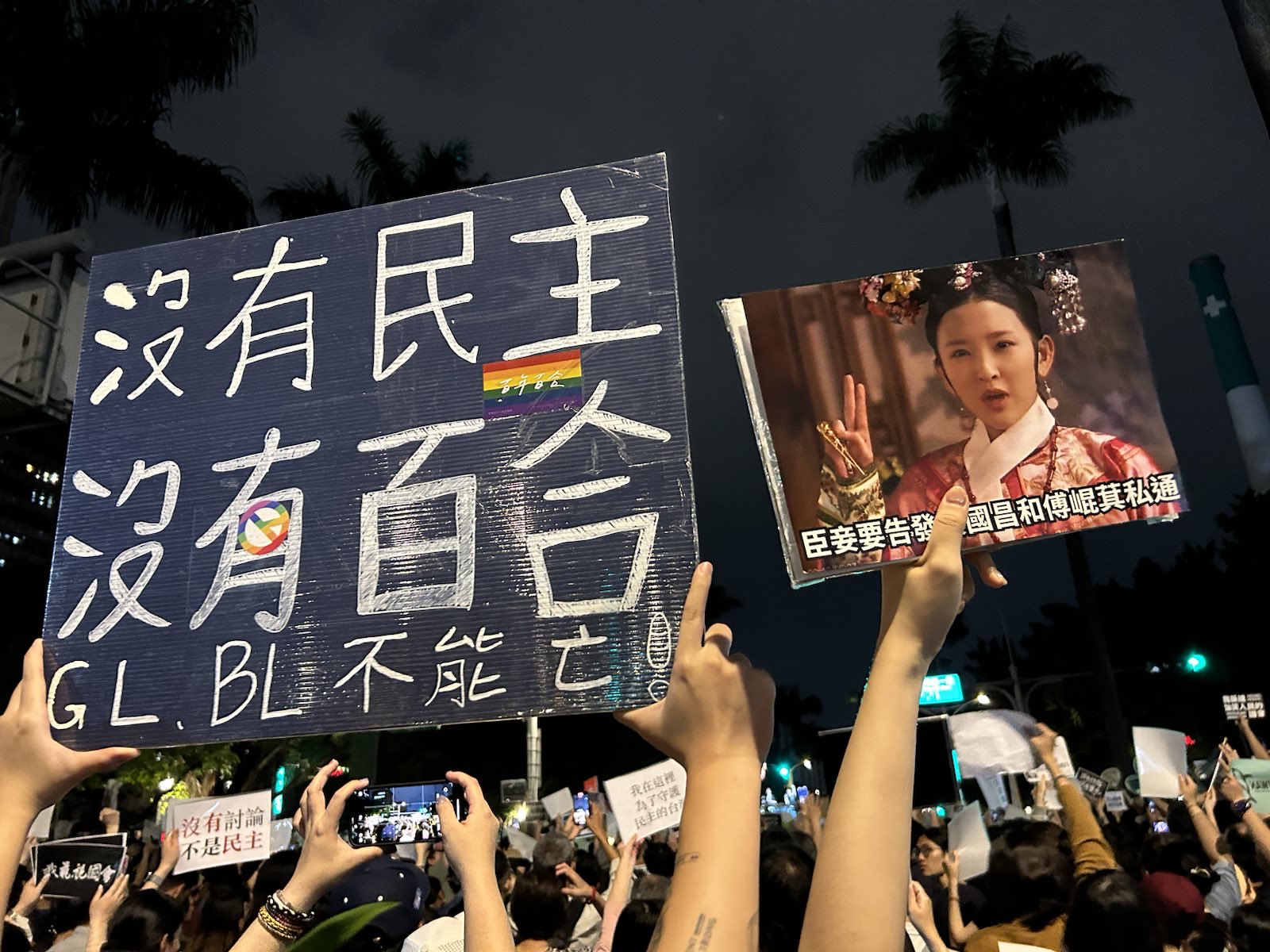by Brian Hioe
語言:
English
Photo Credit: Brian Hioe
OVER 100,000 DEMONSTRATED in Taipei today against the legal amendments that the KMT and TPP are intent on railroading through the Taiwanese legislature. The demonstration started at 9 AM and ended around midnight when the legislative session ended. The protest was clearly one of the largest demonstrations in Taiwan since the 2014 Sunflower Movement, particularly seeing as most protests of this size in the years since then have been daytime protests that were planned ahead of time, and took place during the daytime on weekends.
 The protest shortly after 9 AM. Photo credit: Brian Hioe
The protest shortly after 9 AM. Photo credit: Brian Hioe
It is feared that the legal amendments that the KMT and TPP aim to push through the Taiwanese legislature would grant unaccountable power to pan-Blue legislators. Namely, through the new powers, legislators would be able to summon individuals for questioning. Those who do not comply could be jailed on charges of contempt against the legislature. Those who do not answer, even if this means disclosing trade secrets or classified information related to national security, could face fines that could be imposed successively–even with the suggestion that fines could be to the level of bankrupting companies. Civil society groups such as those involved in organizing the demonstration today could potentially be targeted by investigation groups that can be formed through the new legal amendments.
 Photo credit: Brian Hioe
Photo credit: Brian Hioe
Protestors have raised that the new legal measures could, in this way, lead to pan-Blue legislators involved in corruption forcing trade secrets out of businesses, to profit personally, or to force competitors to publicize trade secrets. The national security dimension of the legal amendments, in that KMT legislators such as Ma Wen-chun, co-chair of the defense committee of the Legislative Yuan, have been accused of leaking secrets about Taiwan’s domestic submarine to China, has been less discussed.
 Photo credit: Brian Hioe
Photo credit: Brian Hioe
It may be that demonstrators do not wish to be accused of trying to capitalize on anxieties about cross-strait tensions to attack the pan-Blue camp. Indeed, one notes that while China launched a two-day series of military exercises to take place around Taiwan to show displeasure with the inauguration of Lai Ching-te of the DPP, there were few references to this during the protest today. Taiwanese generally do not react to military threats from China, even though the demonstration shows that Taiwanese are concerned about the threat of China, with the KMT framed throughout as a pro-China party that undermines the operations of Taiwanese democracy.
 Photo credit: Brian Hioe
Photo credit: Brian Hioe
The KMT continues to be intent on pushing through the legal amendments, with KMT legislators taking shifts overnight to prevent the DPP from seizing the speaker’s podium of the Legislative Yuan starting on Wednesday night. Clashes in the legislature have continued in the days since, though not with the severity of last week in the series of fights that provoked the protests.
As the laws are still in their second reading, the laws should next go to a third reading, during which there can still be questions and concerns raised about the laws. But there are concerns about the KMT skipping the normal legislative process to try and push the law through, it is a question if this will happen. The KMT has only allowed DPP legislators three minutes each to speak and voting is conducted by raising hands for those who support the bill and those who oppose it consecutively.
 Members of Lin Yi-hsiung’s People Rule organization. Photo credit: Brian Hioe
Members of Lin Yi-hsiung’s People Rule organization. Photo credit: Brian Hioe
The pan-Blue camp has embraced guavas as a symbol of their struggle against the DPP, accusing the DPP of “bounced checks” in terms of political promises that they have failed to live up to. As “guava checks” is a term in Taiwanese Hokkien to refer to bounced checks, this has led to the pan-Blue camp criticizing the “guava votes” of the DPP and accusing it of being a “guava party”, starting with the TPP introducing this vocabulary into the discourse around the legislative changes during their demonstration of 8,000 on Sunday.
 Wall for artworks in the legislature. Photo credit: Brian Hioe
Wall for artworks in the legislature. Photo credit: Brian Hioe
Today in the legislature, DPP legislators released blue and white balloons and held up blue and white sandals, as commonly seen in Taiwan, to criticize the KMT and TPP seeing as blue and white are the party colors of the two parties respectively. The conflict between the two parties did not prevent a brief truce between the two parties yesterday in which they ate guava with plum juice together and called on the public to support Taiwanese agricultural products.
A press conference was held at 9:30 AM to kick off the proceedings of the protest. Within an hour, seats on Qingdao East Road were quickly filled up, spilling over to a secondary stage set up on Jinan Road. According to protesters, there were 3,000 protesters in around the first hour or hour and a half. It took until noon for the protest to become 3,000 people on Tuesday.
 The Che-Lam Presbyterian Church. Photo credit: Brian Hioe
The Che-Lam Presbyterian Church. Photo credit: Brian Hioe
This set the tone for the rapid expansion of the protest. By mid-afternoon and early evening, 30,000 people were on-site. This ballooned to 80,000 and eventually over 100,000 in the span of a few hours, with the protest spilling out onto Xuzhou Road, both sides of Zhongshan South Road, and later Zhongxiao West Road. The two primary stage areas on Jinan Road and Qingdao East Road were so full of individuals that crowd control measures were implemented. Multiple speaker trucks were set up for speeches.
The underground party collective Rave Fun Taiwan also set up a booth to play music. Various musicians, such as drummers, tuba, saxophone, and violin players were present to provide music.
 Musicians during the demonstration. Photo credit: Brian Hioe
Musicians during the demonstration. Photo credit: Brian Hioe
The Che-Lam Presbyterian Church was a major presence during the demonstration. The church itself served as a site for demonstrators to rest while watching a livestream of the proceedings in the Legislative Yuan, to eat and drink water, as well as use the bathroom. The church donated many snacks and plastic bottles of water to the demonstrators, with various tents set up to distribute such supplies. Surprisingly, Want Want crackers were among the food products distributed at the supply stations. The Green Party Taiwan began to hand out guavas through the demonstration.
 Massages in the protest. Photo credit: Brian Hioe
Massages in the protest. Photo credit: Brian Hioe
On Jinan Road, a wall was set up for artwork. Numerous memorials to Huang Kuo-chang as though he were dead, in light of his large political shifts in past years, were set up through the demonstration. Likewise, a tent was set up for massages. As with Tuesday’s protest, areas and tents were set up for childcare, first aid, stickers to be handed out, and more.
Just as sunflowers were handed out at last Tuesday’s protest, lilies were handed out at today’s protest. This references the history of the 2014 Sunflower Movement as well as the 1990 Wild Lily Movement. Many of the signs held up by participants were Internet memes.
Threads has taken on an unusual role in the protests. Namely, Threads is a newer social media network, and protest organizers find that it has allowed for reaching outside of one’s echo chamber.
 Photo credit: Brian Hioe
Photo credit: Brian Hioe
Nymphia Wind, the recent winner of RuPaul’s Drag Race, also made an appearance, as she also did during Tuesday’s demonstration. Apart from performing, many speakers during the various open mic sessions referenced comments by Nymphia about her pride as a Taiwanese person.
To this extent, speakers included Indigenous, who reflected on systematic issues of discrimination in Taiwan, “new residents” who are the children of immigrants from Southeast Asia, Hongkongers, queer activists, and others. There were many rainbow flags present, sometimes combined with symbols of Taiwan. A number of comments during open mic sessions called on protesters to avoid discriminatory or sexist speech, as often occurs in social movement settings, or to avoid creating hero figures such as might lead to another political turncoat such as Huang Kuo-chang. Huang has continued to be a frequently criticized figure in comments by demonstrators or in terms of signs held up by demonstrators. Huang is aligned with KMT caucus convener Fu Kun-chi and KMT Legislative Yuan president Han Kuo-yu.
 Photo credit: Brian Hioe
Photo credit: Brian Hioe
Local identity was a point of emphasis, with individuals called on ahead of time to take the day off from school or work to protest. Some traveled from other parts of Taiwan, including the south, or outlying islands. Demonstrations were held concurrently in Taichung, Changhua, Chiayi, Tainan, Kaohsiung, and Taitung.
As with before, the crowd often chanted in support of DPP legislators when they appeared on the walkway above the main stage. MCs for the event were careful to steer the crowd toward chants not specifically celebratory of the DPP, to avoid the allegation of the protests being fomented by the DPP. There has been much public anger in particular against Huang Kuo-chang for claims that the crowd was simply stirred up by the DPP, as well as that KMT legislators applied for police protection with the claim that the DPP has aligned with gangsters to demonstrate against them.
Speakers explicitly told demonstrators not to engage in forms of direct, in that this would be used to frame protesters as violent and irrational. Still, as these were the groups that planned the Sunflower Movement, direct action is likely being reserved for when the laws seem closer to passing into law.
 Photo credit: Brian Hioe
Photo credit: Brian Hioe
As with before, many participants were high school students or college students, who sometimes reflected on their lack of experience with large-scale protests in comments. By contrast, protesters who did experience the Sunflower Movement often touched on how the main organizers of the protests were largely the same as ten years ago. In many ways, the current protests are organized by Sunflower Movement veterans–just those who continued to work at the grassroots level of politics and did not become movement superstars.
This emphasis on pluralism and diversity contrasts with the heavy male attendance at the TPP’s rally against the DPP last Sunday and emphasis on macho figures such as Huang Kuo-chang or Holger Chen, or with regards to Ko Wen-je’s history of forays into misogyny. It may be, then, that there is something of a struggle regarding two different groups of Taiwanese young people, one of which is more progressive and the other more conservative.
 Photo credit: Brian Hioe
Photo credit: Brian Hioe
The demonstration began to wind down around 11 PM, with the vibe seeming much like a party by early evening. The Economic Democracy Union, the main group coordinating the protests, announced that for a line-by-line review of the bill to be completed would require more than 4.5 hours and the legislature was scheduled to adjourn by midnight, calling on protesters on different parts of the protest. The legislature itself ended the session early at 11:30. A last train was added to the Taipei MRT given the large number of people on the streets.
Discussion of the bill will subsequently take place on Tuesday when the laws are to be discussed next. It was expected that today’s protest would be larger than last Tuesday due to it being a Friday night. It is to be seen as to the size of Tuesday’s mobilization, but it will likely follow a similar script.
 Photo credit: Brian Hioe
Photo credit: Brian Hioe
50 civic groups have signed a statement against the legal changes. Overseas mobilizations of Taiwanese students and diaspora groups are also currently in the works.
Still, the endgame of the protests is yet unclear. After passing a second reading, the bill would go to a third reading that can still allow for review, but as the KMT circumvented review measures already, it is a question whether this would occur again. There is no precedent for the president refusing to implement a bill, which would lead to a constitutional crisis.
 Performance by Nymphia Wind. Photo credit: Brian Hioe
Performance by Nymphia Wind. Photo credit: Brian Hioe
Furthermore, the demonstrators hope to show how they have aimed to maintain process, rather than break from it. A frequent slogan seen in the protests is “Without discussion, there cannot be democracy” and “Without process, there cannot be democracy,” referring to how the KMT is seen as having tried to ram the legal changes through without discussion and by violating process.
Either way, newly inaugurated President Lai Ching-te weighed in on the controversy today with a statement released after the legislature adjourned. Lai urged respect for process and for personal freedoms.
View this post on Instagram
Statement by Lai Ching-te on the protests
The Executive Yuan could potentially raise issues with the bill, or the Constitutional Court may rule against it. But this is to be seen.
Otherwise, it is possible the KMT and TPP back away from the bill, especially if splits open up between the two parties. Yet this seems unlikely at present. As such, protests will continue. It is to be seen whether this sets a precedent for continual protests during the Lai presidency–after all, part of the reason why the protests have occurred is that the public feels threatened by the KMT’s current majority in the legislature, as well as the KMT’s willingness to press ahead with controversial legal changes.

